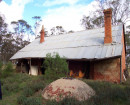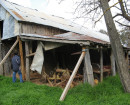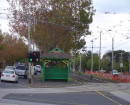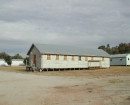CHANDLER HIGHWAY BRIDGE
CHANDLER HIGHWAY ALPHINGTON AND CHANDLER HIGHWAY KEW, YARRA CITY, BOROONDARA CITY
-
Add to tour
You must log in to do that.
-
Share
-
Shortlist place
You must log in to do that.
- Download report






















Statement of Significance
What is significant?
How is it significant?
Why is it significant?
-
-
CHANDLER HIGHWAY BRIDGE - History
HISTORY
Construction of the Outer Circle Railway Line and Yarra River Rail Bridge (later the Chandler Highway Bridge)
On 12 December 1884 the construction of Melbourne's Outer Circle Railway Line was approved under the 1884 Railway Construction Act which authorised sixty-two new railway lines in Victoria. It was conceived during the 1860s and 1870s at a time when most of Melbourne's railways were privately operated. The Outer Circle Railway (built to the north east of Melbourne) was designed to link the Gippsland Railway to the inner eastern suburban railway system, and then to Flinders Street Station, Spencer Street Station and Good Yards such as the Newmarket Saleyards. The Outer Circle Railway was built to carry passenger trains as well as livestock, firewood and other freight. It was hoped that the railway would stimulate residential development in suburban Melbourne which had been rapidly growing in population from the 1870s.
The Victorian Government contract for construction of the line was let to builders Graham & Wadick on 13 April 1888 and the line was opened in March 1891 having cost £297,361 to build. The Yarra River Bridge (later known as the Chandler Highway Bridge) cost £23,000. There were other bridges built on the line including the 'Black Bridge' spanning Gardiner's Creek (a single line rail timber trestle bridge, now demolished) and the Canterbury Road Bridge over the rail line to the south of the former Shenley station. The railway line and its bridges were designed by the Engineer-in-Chief's Branch of the Victorian Railways, under Engineer-in-Chief Robert Watson. Graham and Wadick, employed a young engineer, John Monash as supervising engineer on the project. Monash was twenty-two years old when appointed.
The Chandler Highway Bridge was designed to carry two railway tracks but only one was laid down. During the construction process, the original design was modified to provide an pedestrian walkway, cantilevered from the western side of the bridge trusses. The design of the bridge reflected the conservative nature of the railways - for example their reluctance to use concrete, and their insistence of simply supported rather than continuous span bridges.
The Victorian Government spared no expense on the Outer Circle Railway Line and it was viewed by many as extravagant. Upon completion in 1891, it was 16.6 km in length and had 11 stations all provided with twin platforms and crossing loops. It ran off the Gippsland Railway at Hughesdale (near Oakleigh), went through Ashburton and Camberwell, then entered Kew at Burke Road about 500 metres north of Cotham Road, travelling generally north-west to cross the Yarra River near Fairfield. From there it joined the Heidelberg and Eltham Railway, and ran via a junction at Rushall, on to the Inner Circle Railway through north Fitzroy and North Carlton, to connect with the Coburg line in Royal Park, near the Zoo. Between Fairfield Park (later Fairfield) and Riversdale Stations, a single steam locomotive ran up and down the line during the day, crossing the Chandler Highway Bridge on its route.
Closure Yarra River Rail Bridge (later the Chandler Highway Bridge) and Failure of the Outer Circle Railway LineDespite the impressive Government investment in the Outer Circle Railway Line, it was ultimately a grand failure. By 1885 it was claimed that two parliamentarians who helped approve the line, FE Beaver and James Munro, purchased land adjoining the new railway. Public controversy ensued over land speculation, the design of the line and excessive government spending. There was a lack of patronage and in 1893 the Fairfield Park to Riversdale section of Outer Circle Railway Line (including the Chandler Highway Bridge) closed. Sections of the Outer Circle Railway Line were progressively shut down until the whole line closed in 1897. Ultimately the line never carried Gippsland traffic because the Oakleigh to Sale (Gippsland) railway line had already opened by 1878, but this did not appear to have deterred those who planned the Outer Circle Railway. The aim of boosting suburban growth stalled when the 1890s depression saw home building all but cease, and many land speculators who purchased property along the line lost their money. The history of the Outer Circle Railway Line typifies the optimism of the 1880s boom and expansion of buildings and infrastruture in Victoria, and the subsequent impact of the 1890s economic depression in Melbourne.
During the following years and decades, sections of the Outer Circle Railway Line opened and closed. Passenger services on the section from Riversdale to Deepdene were resumed in May 1900, with the 'Deepdene Dasher', a small steam hauled train which ran between Deepdene and Ashburton. The early 1920s saw the electrification of Melbourne's train lines. An electric train from Camberwell took over the trip to Ashburton and the northern section steam passenger trains operated only between Deepdene and Riversdale with passengers for Melbourne changing at East Camberwell. The last steam-hauled Deepdene Dasher ran on 15 August 1926 and was replaced by two railmotors coupled back to back. On 10 October 1927 the train was replaced by a bus service between East Camberwell and Deepdene, extending in 1929 to East Kew. The Deepdene Dasher was the last passenger steam train in suburban Melbourne. By the 1920s Melbourne's electric tram system was operational and became a preferred form of transport in the eastern suburbs because of its frequency of service, speed and routes past local shopping strips and into the employment areas of inner Melbourne.
Reopening of Chandler Highway Bridge as a Road Bridge
The northern section of the Outer Circle Railway from Riversdale to Fairfield Park (which included the Chandler Highway Bridge) was officially closed on 12 April 1893. The Bridge was to lie idle for most of the following 37 years (to 1930) except for the occasional use by pedestrians wishing to cross from Fairfield to Studley Park. A short section of the line on the northern side of the river was reopened in 1919 from Fairfield Park for goods traffic to the Fairfield Paper Mill (later Australian Paper Mills) and this portion closed in the mid-1990s, though the tracks could still be seen cutting diagonally across Heidelberg Road-Chandler Highway intersection for some years. The railway is no longer evident between Heidelberg Road and Princes street due to widening for the freeway overpass.
The Chandler Highway Bridge was converted from rail to road use in 1930 after the Public Works Department, Board of Land & Works, the Metropolitan Board of Works, and the five councils struck an agreement in November 1929. Works involved the forming and sealing of new approach roads and the laying of 60,000 super-feet of new timber decking on the bridge. A building that was formerly part of the Kew Asylum was demolished as part of the project, allowing the alignment of the southern approach road from the intersection with Princes Street, Kew, to be straightened. Works were completed and the bridge opened for traffic in June 1930.
In September 1930 the new section of road was named the 'Chandler Highway' and the bridge was renamed 'Chandler Bridge', in recognition of the role played by A.E. Chandler (1873-1935) in bringing the project to fruition. During the mid-1930s the Chandler Highway was integrated conceptually into the northern end of the Yarra Boulevard, constructed by unemployed sustenance labour, and hundreds of Lombardy poplars were planted along the route as part of a beautification scheme in preparation for the Centenary of Melbourne in 1935. The Chandler Highway is part of Melbourne's arterial main road network which had its genesis in the Plan of general development, Melbourne: report of the Metropolitan Town Planning Commission of 1929 (see pages 79-80).
The Chandler Highway was originally planned to continue east along the former rail corridor to where Earl, Asquith and Valerie Streets intersect. The highway was to end at High Street in East Kew, and although the route is still listed as a 'proposed arterial' in older editions of the Melway street directory, the reserve has been landscaped. At the interchange with the Eastern Freeway, there are visible pavements reserved for smooth (elevated) entry/exit ramps to be constructed. These proposals are illustrated in the early eighties editions of the Melway directory. The 1969 Melbourne Transportation Plan shows the Chandler Highway as part of the F6 Freeway corridor which would eventually link up to the Mornington Peninsula Freeway. The Chandler Highway is less than 2 kilometres in length, leading to its claim as 'the shortest highway in the world'.
1955-56 Bridge Works
By 1951, the Chandler Bridge was described as being 'dangerously out of repair' and claimed to be 'one of the worst stretches of pot holes in the metropolitan area' being pounded by almost 4,000 vehicles a day, including 1,200 trucks and buses. The bridge was subsequently strengthened in 1955-56 by the Country Roads Board when much of the deck was renovated and this may also be the date for the welding reinforcement of the horizontal chords of the trusses. It has been claimed the bridge was widened in the 1950s, but this cannot be substantiated. The strengthening works that were carried out in the 1950s involved welding up the truss work, installing additional gusset and brace plates, and adding welded box sections to the upper chords of the trusses, which extend for about a third of the length of the chords in the mid-section. A small cabin was erected on top of the north-west pillar of the bridge around this time - its function is uncertain, but it appears to be related to the strengthening works - perhaps to assist with traffic control as the bridge was retained in use during the works.
Present day
Today the Chandler Highway Bridge carries an average of 44,000 vehicles per day. On the north side of the Bridge, the former railway alignment can be traced through the former Australian Paper Mill (Amcor) works where tracks from the siding remain, and across Heidelberg Road to the junction with the Hurstbridge rail line (the section crossing the road has now been removed). The only operational rail section of the Outer Circle Railway Line that remains today is the Alamein Line. Extant infrastructure include a number of road over rail bridges, various platform mounds, cuttings, embankments and archaeological features, and the remains of a timber pylon from the 'Black Bridge' a railway bridge spanning Gardiner's Creek (now demolished). Some of the Outer Circle Railway Line is now a linear park with cycle tracks (including the Anniversary Bike Trail) and there has been some heritage interpretation of remnant elements.
Timeline
Date
Event
1884
Railway Construction Act
1887
Tenders called - Construction of the Outer Circle Railway Line
1888
Construction commences - Outer Circle Railway Line
February
1889
Construction commences - Yarra River Bridge
November 1890
Construction complete - Yarra River Bridge
March
1891
Opened - Outer Circle Railway Line
12 April
1893
Closed - Fairfield Park to Riversdale Line section of Outer Circle Railway Line (includes the Yarra River Bridge)
1895
Closed - Oakleigh to Ashburton section of Outer Circle Railway Line
1897
Closed - Whole of Outer Circle Railway Line close when trains stopped running between Ashburton and Camberwell
1898
Reopened - Ashburton to Camberwell
1900
Reopened - Riversdale to Deepdene (the 'Deepdene Dasher')
1919
Reopened - Line from Fairfield Park to APM (Australian Paper Mill) for goods traffic.
1927
Closed - Last remaining sections of Outer Circle Railway Line (Deepdene to Ashburton) and buses replace trains.
1930
Dismantled - Railway Line from the Chandler Bridge to Princess Street Kew and bridge became used by vehicular traffic.
1946
Dismantled - Outer Circle Railway Line.
Mid-1990s
Closed - Line between Fairfield Park and APM (Australian Paper Mill) for goods traffic.
KEY REFERENCES USED TO PREPARE ASSESSMENTAllom Lovell & Associates, Citation for Chandler Highway Bridge, City of Yarra Heritage Review, 1998.
Beardsell, D. The Outer Circle: A History of the Oakleigh to Fairfield Park Railway, Australian Railway Historical Society (Victorian Division), 1979.
Beardsell, D. The Outer Circle: Melbourne's Forgotten Railway, DVD, Evolving Communications and Shack West, 2014.
City of Boroondara (Kew), Citation for Former Outer Circle Railway Bridge, Chandler Highway, 1983.
City of Yarra, Citation for Outer Circle Railway line bridge, later Chandler Highway Bridge, over Yarra River, HO67.
Metropolitan Town Planning Commission, Stapley, Frank, Plan of general development, Melbourne: report of the Metropolitan Town Planning Commission, HJ Green, Government Printer, 1929.
Vines, G. (Biosis Research Pty Ltd) and Ken McInnes, Metal Bridges Study, National Trust of Australia (Victoria) With assistance from VicRoads and Heritage Victoria, 2003 (Revised August 2010).
Vines, G. (Biosis Research Pty Ltd), Victoria's Rail and Masonry Bridges, National Trust of Australia (Victoria) With assistance from VicRoads and Heritage Victoria (2011).Vines, G. (Biosis Research Pty Ltd), Chandler Highway Upgrade Heritage Impact Statement, Prepared for VicRoads, December 2015.
National Trust Citation for John Foord Bridge over the Murray River, Victorian Heritage Database.
CHANDLER HIGHWAY BRIDGE - Plaque Citation
The Chandler Highway Bridge (1890) is an uncommon lattice truss bridge and one of the last surviving remnants of Melbourne's steam-era Outer Circle Railway Line. In 1930 the Bridge was converted to accommodate vehicular traffic.
CHANDLER HIGHWAY BRIDGE - Assessment Against Criteria
Criterion
Following is the Executive Director's assessment of the place against the tests set out in The Victorian Heritage Register Criteria and Thresholds Guidelines (2014).
CRITERION AImportance to the course, or pattern, of Victoria's cultural history.
STEP 1: A BASIC TEST FOR SATISFYING CRITERION A
The place/object has a clear ASSOCIATION with an event, phase, period, process, function, movement, custom or way of life in Victoria's cultural history.
Plus
The association of the place/object to the event, phase, etc IS EVIDENT in the physical fabric of the place/object and/or in documentary resources or oral history.
Plus
The EVENT, PHASE, etc is of HISTORICAL IMPORTANCE, having made a strong or influential contribution to Victoria.
Executive Director's Response
. The Chandler Highway Bridge was built as part of the Outer Circle Railway Line which has a clear association with the expansion of Melbourne's suburban rail network from the late nineteenth century which facilitated the growth of Melbourne and its suburbs.
. The Chandler Highway Bridge was authorised during the 1880s economic boom but was only in use between 1891 and 1893, becoming a symbol of the failure of the Outer Circle Railway Line.
. Its adaptive reuse as a road bridge from 1930 demonstrates the re-conceptualisation of Melbourne's arterial road network in the city's first strategic plan of 1929.
. This association of the Chandler Highway Bridge with Victoria's ambitious program of railway construction during the 1880s boom and the 'bust' of the 1890s depression, and the development of Melbourne's arterial road network is evident in the physical fabric of the Chandler Highway Bridge and documentary resources.
. The Victorian Government's program of rail and road construction from the 1880s made strong and influential contribution to the state.
Criterion A is likely to be satisfied.
STEP 2: A BASIC TEST FOR DETERMINING STATE LEVEL SIGNIFICANCE FOR CRITERION A
The place/object allows the clear association with the event, phase etc. of historical importance to be UNDERSTOOD BETTER THAN MOST OTHER PLACES OR OBJECTS IN VICTORIA WITH SUBSTANTIALLY THE SAME ASSOCIATION.
Executive Director's Response
. The Chandler Highway Bridge is the most substantial extant engineering remnant of the Outer Circle Railway Line.
. The Chandler Highway Bridge allows the clear association with Victoria's ambitious program of railway construction authorised during the 1880s boom, and the effects of the 'bust' of the 1890s depression to be understood better than most other places or objects in Victoria with substantially the same association.
. There is currently no registration associated with the Outer Circle Railway line in the VHR.
Criterion A is likely to be satisfied at the State level.CRITERION B
Possession of uncommon, rare or endangered aspects of Victoria's cultural history.
STEP 1: A BASIC TEST FOR SATISFYING CRITERION B
The place/object has a clear ASSOCIATION with an event, phase, period, process, function, movement, custom or way of life of importance in Victoria's cultural history.
Plus
The association of the place/object to the event, phase, etc IS EVIDENT in the physical fabric of the place/object and/or in documentary resources or oral history.
Plus
The place/object is RARE OR UNCOMMON, being one of a small number of places/objects remaining that demonstrates the important event, phase etc.
OR
The place/object is RARE OR UNCOMMON, containing unusual features of note that were not widely replicated
OR
The existence of the class of place/object that demonstrates the important event, phase etc is ENDANGERED to the point of rarity due to threats and pressures on such places/objects.
Executive Director's Response
. The Chandler Highway Bridge has a clear association with the lattice truss bridge type.
. This association is evident in the physical fabric and documentary resources.
. The Chandler Highway Bridge is an example of an uncommon bridge type, the lattice truss bridge.
Criterion B is likely to be satisfied.
STEP 2: A BASIC TEST FOR DETERMINING STATE LEVEL SIGNIFICANCE FOR CRITERION B
The place/object is RARE, UNCOMMON OR ENDANGERED within Victoria.
Executive Director's Response
. The Chandler Highway Bridge is an example of an uncommon bridge type (lattice truss bridges) in Victoria.
. Apart from some railway footbridges, the lattice truss bridge form is only represented in Victoria by three earlier bridge trusses imported from Britain (the Hawthorn Bridge (1861) (VHR H0050), Mia Mia/Redesdale Bridge (1868) (VHR H1419) and the Bell Street Bridge (1880).
. The design of the Chandler Highway Bridge represents a transitional stage between the earlier lattice truss bridges of the 1860s-80s and the more mathematically derived open web trusses at the turn of the twentieth century.
. The Chandler Highway Bridge is an outstanding and pivotal example of the lattice truss bridge form.
Criterion B is likely to be satisfied at the State level.
CHANDLER HIGHWAY BRIDGE - Permit Exemptions
General Exemptions:General exemptions apply to all places and objects included in the Victorian Heritage Register (VHR). General exemptions have been designed to allow everyday activities, maintenance and changes to your property, which don’t harm its cultural heritage significance, to proceed without the need to obtain approvals under the Heritage Act 2017.Places of worship: In some circumstances, you can alter a place of worship to accommodate religious practices without a permit, but you must notify the Executive Director of Heritage Victoria before you start the works or activities at least 20 business days before the works or activities are to commence.Subdivision/consolidation: Permit exemptions exist for some subdivisions and consolidations. If the subdivision or consolidation is in accordance with a planning permit granted under Part 4 of the Planning and Environment Act 1987 and the application for the planning permit was referred to the Executive Director of Heritage Victoria as a determining referral authority, a permit is not required.Specific exemptions may also apply to your registered place or object. If applicable, these are listed below. Specific exemptions are tailored to the conservation and management needs of an individual registered place or object and set out works and activities that are exempt from the requirements of a permit. Specific exemptions prevail if they conflict with general exemptions. Find out more about heritage permit exemptions here.Specific Exemptions:It should be noted that Permit Exemptions can be granted at the time of registration (under s.42(4) of the Heritage Act). Permit Exemptions can also be applied for and granted after registration (under s.66 of the Heritage Act)
General Condition 1
All exempted alterations are to be planned and carried out in a manner which prevents damage to the fabric of the registered place or object.
General Condition 2
Should it become apparent during further inspection or the carrying out of works that original or previously hidden or inaccessible details of the place or object are revealed which relate to the significance of the place or object, then the exemption covering such works shall cease and Heritage Victoria shall be notified as soon as possible.
General Condition 3
All works should be informed by Conservation Management Plans prepared for the place. The Executive Director is not bound by any Conservation Management Plan, and permits still must be obtained for works suggested in any Conservation Management Plan.
General Condition 4
Nothing in this determination prevents the Heritage Council from amending or rescinding all or any of the permit exemptions.
General Condition 5
Nothing in this determination exempts owners or their agents from the responsibility to seek relevant planning or building permits from the relevant responsible authority, where applicable.
Specific Permit Exemptions
Landscape Exemptions:
. The process of gardening, including mowing, hedge clipping, disease and weed control, and maintenance to care for existing plants.
. Pruning, lopping or removal of trees and vegetation.
. Planting of trees and vegetation.
. Subsurface works involving the installation, removal or replacement of watering and drainage systems or services on the condition that works do not impact on archaeological features or deposits
. Removal of plants listed as noxious weeds in the Catchment and Land Protection Act 1994.
. Vegetation protection and management of possums and vermin.
Specific Exemptions:
. Emergency and safety works to secure the site and prevent damage and injury to property and the public. Urgent or emergency site works are to be undertaken by an appropriately qualified specialist such as a structural engineer, or other heritage professional.
. Emergency stabilisation (including propping) necessary to secure safety where a site feature has been irreparably damaged or destabilised and represents a safety risk.
. The erection of temporary security fencing, scaffolding, hoardings or surveillance systems to prevent unauthorised access or secure public safety which will not adversely affect significant fabric of the place.
. Inspection, repair and maintenance of structural elements, including bridge abutments, piers, concrete members and metallic members such as the trusses, in a manner that does not have a negative impact on the cultural heritage significance of the place.
. Inspection, repair, operation and maintenance of the road and public transport infrastructure, and the shared pedestrian/bicycle path on the southern banks of the Yarra, in a manner that does not have a negative impact on the cultural heritage significance of the place.
. Inspection, repair and maintenance of fixtures, including handrails, chairs, drainage, lighting and signage, in a manner that does not have a negative impact on the cultural heritage significance of the place.
. Inspection, repair, operation and maintenance of services, including electricity, lighting, telecommunications, drainage, sewerage and water in a manner that does not have a negative impact on the cultural heritage significance of the place.
. Temporary works that do not affect the cultural heritage significance of the place, such as the placement of traffic management signage, in a manner that does not have a negative impact on the cultural heritage significance of the place.
CHANDLER HIGHWAY BRIDGE - Permit Exemption Policy
The purpose of the Permit Policy is to assist when considering or making decisions regarding works to a registered place. It is recommended that any proposed works be discussed with an officer of Heritage Victoria prior to making a permit application. Discussing proposed works will assist in answering questions the owner may have and aid any decisions regarding works to the place.
The extent of registration of the Chandler Highway Bridge in the Victorian Heritage Register affects the whole place shown on Diagram 2354 including the land, all buildings, roads and other features. This includes the cantilevered walkway. Under the Heritage Act 1995 a person must not remove or demolish, damage or despoil, develop or alter or excavate, relocate or disturb the position of any part of a registered place or object without approval. It is acknowledged, however, that alterations and other works may be required to keep places and objects in good repair and adapt them for use into the future.
If a person wishes to undertake works or activities in relation to a registered place or registered object, they must apply to the Executive Director, Heritage Victoria for a permit. The purpose of a permit is to enable appropriate change to a place and to effectively manage adverse impacts on the cultural heritage significance of a place as a consequence of change. If an owner is uncertain whether a heritage permit is required, it is recommended that Heritage Victoria be contacted.
Permits are required for anything which alters the place or object, unless a permit exemption is granted. Permit exemptions usually cover routine maintenance and upkeep issues faced by owners as well as minor works or works to the elements of the place or object that are not significant. They may include appropriate works that are specified in a conservation management plan. Permit exemptions can be granted at the time of registration (under s.42 of the Heritage Act) or after registration (under s.66 of the Heritage Act).
It should be noted that the addition of new buildings to the registered place, as well as alterations, requires a permit, unless a specific permit exemption is granted.
Conservation management plans
It is recommended that a Conservation Management Plan is developed to manage the place in a manner which respects its cultural heritage significance.
Aboriginal cultural heritage
. Under the Heritage Act 1995 permits are required for any works or activities which alter the place or object, unless a permit exemption is granted. This applies to all parts of the registered place including fabric associated with Aboriginal and non-Aboriginal cultural heritage values.
. If works are proposed which have the potential to disturb or have an impact on Aboriginal cultural heritage it is necessary to contact the Office of Aboriginal Affairs Victoria to ascertain any requirements under the Aboriginal Heritage Act 2006.
. If any Aboriginal cultural heritage is discovered or exposed at any time it is necessary to immediately contact the Office of Aboriginal Affairs Victoria to ascertain requirements under the Aboriginal Heritage Act 2006.
. If this place is registered under both the Heritage Act 1995 and the Aboriginal Heritage Act 2006 the requirements of both Acts need to be met. To establish whether this place is registered under the Aboriginal Heritage Act 2006 please contact the Office of Aboriginal Affairs Victoria.
. The Heritage Act 1995 and the Aboriginal Heritage Act 2006 are separate pieces of legislation. Please be aware that satisfying the requirements of one Act may not satisfy the requirements of the other.
Other approvals
Please be aware that approval from other authorities (such as local government) may be required to undertake works.
Archaeology
Ground disturbance may affect the archaeological significance of the place and, subject to the exemptions stated in this document, requires a permit. Under the terms of the Heritage Act 1995 (see section 127), it is an offence to disturb any historical archaeological site in Victoria, unless Consent has been obtained from the Executive Director. This is a requirement for all historical archaeological sites in the state, regardless of whether they are included in any statutory listing.
Cultural heritage significance
Overview of significance
The cultural heritage significance of the Chandler Highway Bridge lies in its rarity as a lattice truss bridge and its historical importance as one of the last surviving remnant of Melbourne's Outer Circle Railway.
-
-
-
-
-
FORMER WILLSMERE HOSPITAL
 Victorian Heritage Register H0861
Victorian Heritage Register H0861 -
FULHAM GRANGE STATION [OUTER CIRCLE LINE], FAIRFIELD
 Victorian Heritage Inventory
Victorian Heritage Inventory -
ALPHINGTON HOTEL & DAKES STORE
 Victorian Heritage Inventory
Victorian Heritage Inventory
-
3 Sherwood Street
 Yarra City
Yarra City -
Archaeological site
 Southern Grampians Shire
Southern Grampians Shire -
BLACKWOOD HOMESTEAD COMPLEX AND CEMETERY
 Southern Grampians Shire
Southern Grampians Shire
-
-










